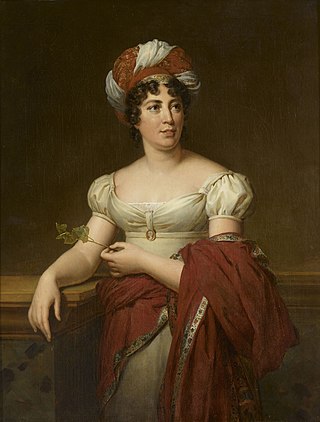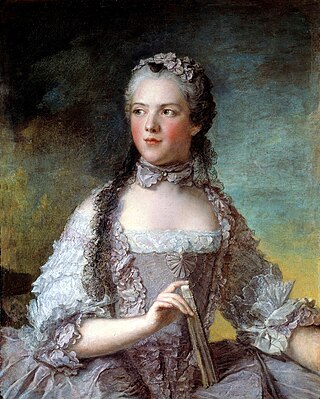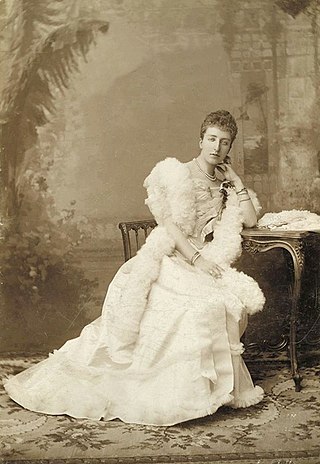
Denis Diderot was a French philosopher, art critic, and writer, best known for serving as co-founder, chief editor, and contributor to the Encyclopédie along with Jean le Rond d'Alembert. He was a prominent figure during the Age of Enlightenment.

Friedrich Melchior, Baron von Grimm was a German-born French-language journalist, art critic, diplomat and contributor to the Encyclopédie ou Dictionnaire raisonné des sciences, des arts et des métiers. In 1765 Grimm wrote Poème lyrique, an influential article for the Encyclopédie on lyric and opera librettos. Like Christoph Willibald Gluck and Ranieri de' Calzabigi, Grimm became interested in opera reform. According to Martin Fontius, a German literary theorist, "sooner or later a book entitled The Aesthetic Ideas of Grimm will have to be written."

Jean François de Saint-Lambert was a French poet, philosopher and military officer.

Anne Louise Germaine de Staël-Holstein, commonly known as Madame de Staël, was a prominent woman of letters and political theorist in both Parisian and Genevan intellectual circles. She was the daughter of banker and French finance minister Jacques Necker and Suzanne Curchod, a respected salonhostess. Throughout her life, she held a moderate stance during the tumultuous periods of the French Revolution and the Napoleonic era, persisting until the time of the French Restoration.
The philosophes were the intellectuals of the 18th-century European Enlightenment. Few were primarily philosophers; rather, philosophes were public intellectuals who applied reason to the study of many areas of learning, including philosophy, history, science, politics, economics and social issues. They had a critical eye and looked for weaknesses and failures that needed improvement. They promoted a "republic of letters" that crossed national boundaries and allowed intellectuals to freely exchange books and ideas. Most philosophes were men, but some were women.

Louise Florence Pétronille Tardieu d'Esclavelles d'Épinay, better known as Mme d'Épinay, was a French writer, a saloniste and woman of fashion, known on account of her liaisons with Friedrich Melchior, Baron von Grimm, and Jean-Jacques Rousseau, who gives unflattering reports of her in his Confessions, as well as her acquaintanceship with Denis Diderot, Jean le Rond d'Alembert, Baron d'Holbach and other French men of letters during the Enlightenment. She was also one of many women referenced in Simone de Beauvoir's The Second Sex as an example of noble expansion of women's rights during the 18th century.

Marie Adélaïde de France was a French princess, the sixth child and fourth daughter of King Louis XV and Queen Marie Leszczyńska.

Antoine Juchereau Duchesnay was the Seigneur of Beauport, Saint-Denis, Fossambault, Gaudarville, and Saint-Roch-des-Aulnaies. He fought with the Troupes de Marine and after the British Conquest of New France joined the British Army, defending Fort Saint-Jean where he was captured and imprisoned by the Americans in 1775. He represented Buckingham County in the 1st Parliament of Lower Canada and was afterwards appointed a member of the Executive Council of Lower Canada.

Anne Henriette of France was a French princess, a fille de France. She was the second child of King Louis XV and Queen Marie Leszczyńska, and the twin of Louise Élisabeth of France. She was also considered the favorite daughter of the royal couple and was known for her sweet and gentle personality.

Louise-Marie of France, OCD was a French princess and Discalced Carmelite, the youngest of the ten children of King Louis XV and Queen Maria Leszczyńska. She entered the Carmelite convent at Saint-Denis in 1770 and took the religious name Thérèse of Saint Augustine. She served as prioress in 1773-1779 and 1785–1787.
Mélanie de Salignac (1741-1763) was a blind French musician whose achievements in the face of her disability were mentioned in the accounts of Diderot.

Princess Henriette of Belgium, was the daughter of Prince Philippe, Count of Flanders, and Princess Marie of Hohenzollern. She was the younger twin sister of Princess Joséphine Marie of Belgium, who died at the age of six weeks in 1871. She was the eldest sister of King Albert I of Belgium.

Charles-Pierre Colardeau was a French poet. His most notable works are an imitation of Eloisa to Abelard by Alexander Pope and a translation of the first two sections of Night-Thoughts by Edward Young. They witness to the pre-Romantic sensibility of the 18th century, as also seen in the works of Rousseau, Diderot and Prévost. He also naturalized Ovid's term. Heroides, as 'héroïdes', imaginary poetic letters by famous people. The relatively small size of his œuvre is attributed by some to his fragile health and by others to proverbial laziness.

Jeanne Sophie de Vignerot du Plessis known as Septimanie d'Egmont was a French salonist.

Madeleine d'Arsant de Puisieux (1720–1798), was a French writer and active feminist.

Women letter writers in early modern Europe created lengthy correspondences, where they expressed their intellect and their creativity; in the process, they also left a rich historical legacy.
Madame de La Carlière, sub-titled On the inconsequence of public judgement of our actions, is a fable written by the French writer Denis Diderot in 1772, and published for the first time in 1798. It was published posthumously, as Diderot had died in 1784.

Didier Diderot was a French craftsman and the father of the encyclopedist, author, philosopher of enlightenment Denis Diderot.
Anne-Antoinette Diderot was the wife of the pioneer encyclopedist Denis Diderot and the mother of his only surviving child, Marie-Angélique Diderot (1753–1824).
Henriette Marx was a Dutch-born woman who was the mother of the communist philosopher Karl Marx.














